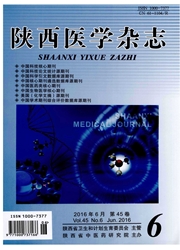

 中文摘要:
中文摘要:
目的:探讨苦参碱对N细胞杀伤急性早幼粒细胞白血病细胞株 HL60的影响及作用机制。方法:实时定量PCR(qRT‐PCR)检测苦参碱处理前后 HL60细胞表面NK细胞活化性受体凝集素样同型二聚体(NKG2D)配体分子MICA、MICB、ULBP1、ULBP2和 ULBP3表达情况, CFSE染色流式法检测苦参碱作用前后 HL60细胞对 NK 细胞杀伤敏感性的改变。结果:qRT‐PCR结果表明1.0 mg/ml苦参碱处理HL60细胞24h后HL60细胞表面MICA和ULBP2表达水平较正常对照组分别增加2.34倍和2.86倍,而MICB、ULBP1和ULBP3与处理前相比差异无统计学意义(P>0.05);处理48h后HL60细胞表面MICA/B、ULBP1/2/3表达水平较处理前均有不同程度升高,尤以ULBP2和 ULBP3升高最明显,较正常对照组分别增加了3.74倍和3.22倍。CFSE染色流式数据显示效靶比例5∶1和10∶1条件下,苦参碱均可加强NK细胞对 HL60细胞的杀伤效率。结论:苦参碱可促进 HL60细胞对NK细胞杀伤敏感性,其机制与诱导 HL60细胞表面NKG2D配体表达上调密切相关。
 英文摘要:
英文摘要:
Objective:To explore the influence of killing efficiency of natural killer cell(NK)on HL60 cell line by matrine and investigate its underlying molecular mechanism .Methods:The expression of NKG2D ligands (major histocompatibility complex class I chain‐related molecule A or B (MICA/B) ,UL16‐binding proteins(ULBP) 1 ,2 ,and 3 on HL60 cells were analyzed before and after treated with matrine by quantitive real‐time PCR (qRT‐PCR) .The cytotoxic sensitivity of HL60 to NK cell was detected by FCM after CFSE staining at different effect‐to‐target (E/T) cell ratios .Results :After treatment with matrine for 24h ,MICA and ULBP2 expression on HL60 cells were significantly increased ,however ,there was no statistically significant difference between MICB ,ULBP1/3 ex‐pression and normal control group .After treatment with matrine for 48h ,the expression of MICA/B ,ULBP1/2/3 were increased inordinately .Flow cytometry results showed that at the ratio of E/T with whether 5∶1 or 10∶1 ,the proportion of the killed HL60 cells were increased by matrine treatment .Conclusion :Matrine can promote the killing efficiency of NK on HL60 cell line ,which is closely related to up‐regulation of NKG2D ligands .
 同期刊论文项目
同期刊论文项目
 同项目期刊论文
同项目期刊论文
 期刊信息
期刊信息
